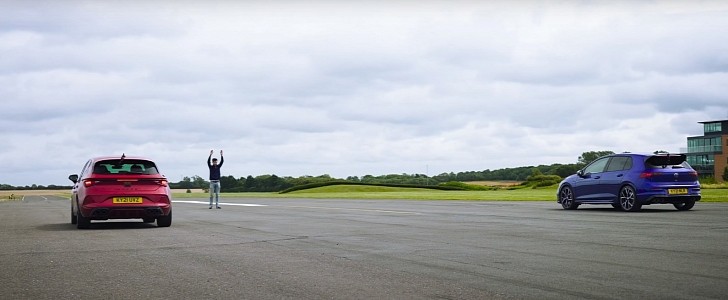Ever wonder what is the difference between a VW Golf R and a Cupra Leon 300 in a drag race? But what about a braking test from 70 mph (112 km/h)? Both questions, and a few in between, are answered in the latest comparison test made by the Brits at Carwow.
As you may know, Volkswagen's Mk8 Golf R only comes with all-wheel drive, while Cupra's Leon 300 is only available with front-wheel drive. There is also a difference in power and torque, with the Golf getting more, but the German model is also heavier.
It is worth pointing out that Volkswagen does offer the Golf R with a manual gearbox as well, but only in the U.S., which is an interesting touch. Both the Golf R and the Leon have launch control available with their twin-clutch automated gearboxes.
The VW Golf R tips the scales at 1,550 kg, while the Cupra Leon 2.0 TSI 300 comes in at 1,395 kilograms. With that in mind, along with a seven-speed DSG gearbox available for both models, one cannot help but wonder if the difference in weight will provide an advantage for the Leon against the Golf R.
The 2.0 TSI motor under the hood of the Golf R provides 320 ps (315 horsepower), while the 2.0 TSI of the Cupra Leon offers 300 ps (295 horsepower). There is also a difference in peak torque, as the Golf offers a maximum of 420 Nm (309 lb.-ft), while the Leon comes with 400 Nm (295 lb.-ft).
On top of AWD and FWD, along with disregarding final drive and gear ratios, the difference between the two models sits at 20 horsepower and 20 Nm (ca. 14 lb.-ft), along with 155 kilograms (ca. 341 lbs.). While the Golf R has an advantage off the line with its all-wheel-drive system, the Leon should be quicker from a rolling start.
The Brits at Carwow have also put the two models through a braking test that started at 70 mph (112 km/h) to see which one would get the best result.
It is worth pointing out that Volkswagen does offer the Golf R with a manual gearbox as well, but only in the U.S., which is an interesting touch. Both the Golf R and the Leon have launch control available with their twin-clutch automated gearboxes.
The VW Golf R tips the scales at 1,550 kg, while the Cupra Leon 2.0 TSI 300 comes in at 1,395 kilograms. With that in mind, along with a seven-speed DSG gearbox available for both models, one cannot help but wonder if the difference in weight will provide an advantage for the Leon against the Golf R.
The 2.0 TSI motor under the hood of the Golf R provides 320 ps (315 horsepower), while the 2.0 TSI of the Cupra Leon offers 300 ps (295 horsepower). There is also a difference in peak torque, as the Golf offers a maximum of 420 Nm (309 lb.-ft), while the Leon comes with 400 Nm (295 lb.-ft).
On top of AWD and FWD, along with disregarding final drive and gear ratios, the difference between the two models sits at 20 horsepower and 20 Nm (ca. 14 lb.-ft), along with 155 kilograms (ca. 341 lbs.). While the Golf R has an advantage off the line with its all-wheel-drive system, the Leon should be quicker from a rolling start.
The Brits at Carwow have also put the two models through a braking test that started at 70 mph (112 km/h) to see which one would get the best result.








